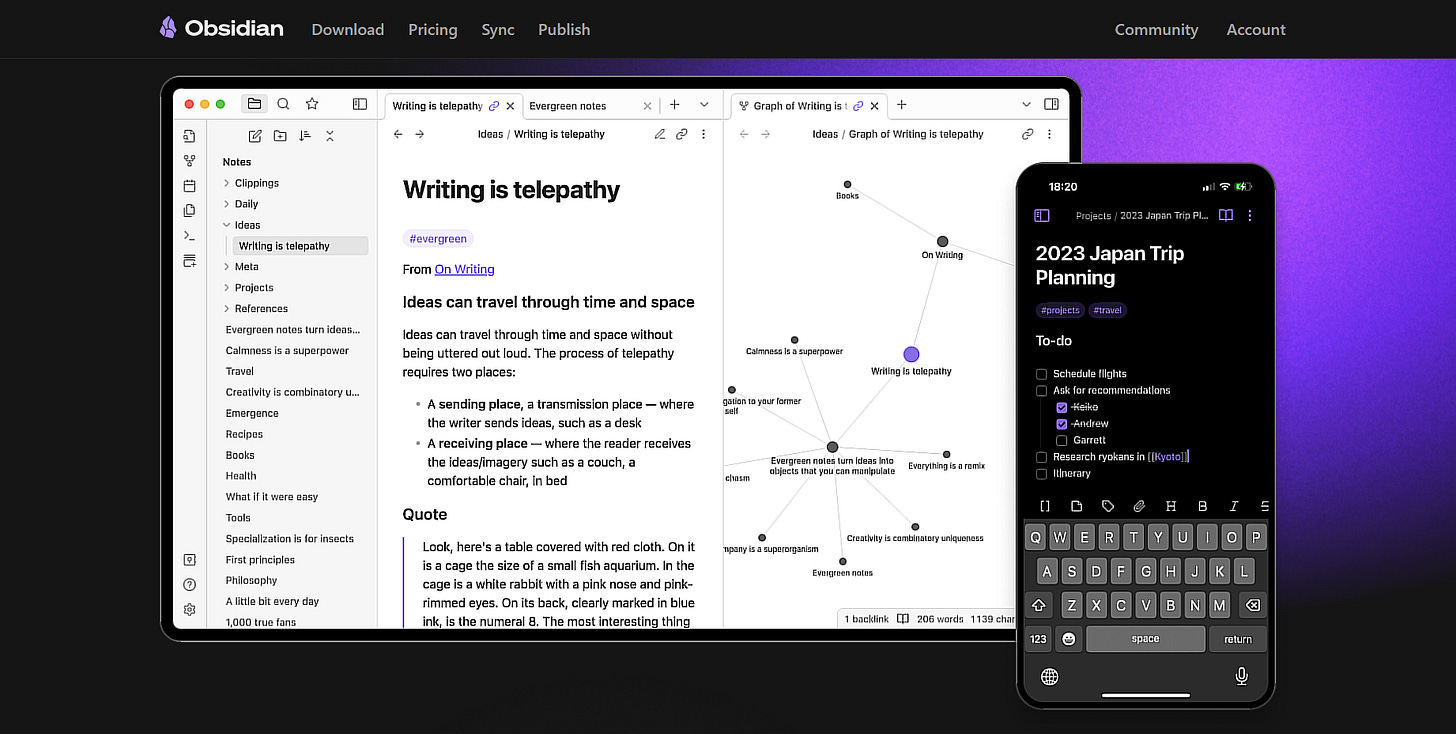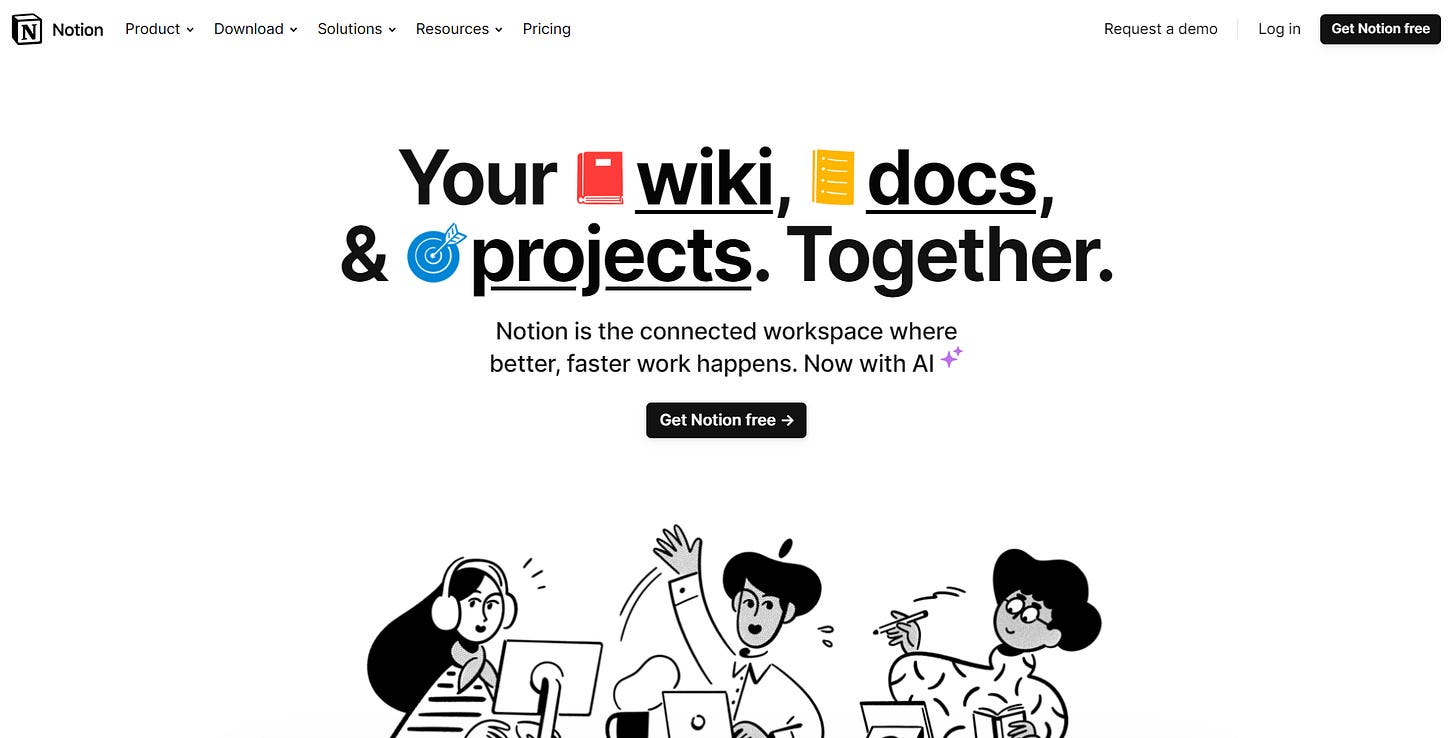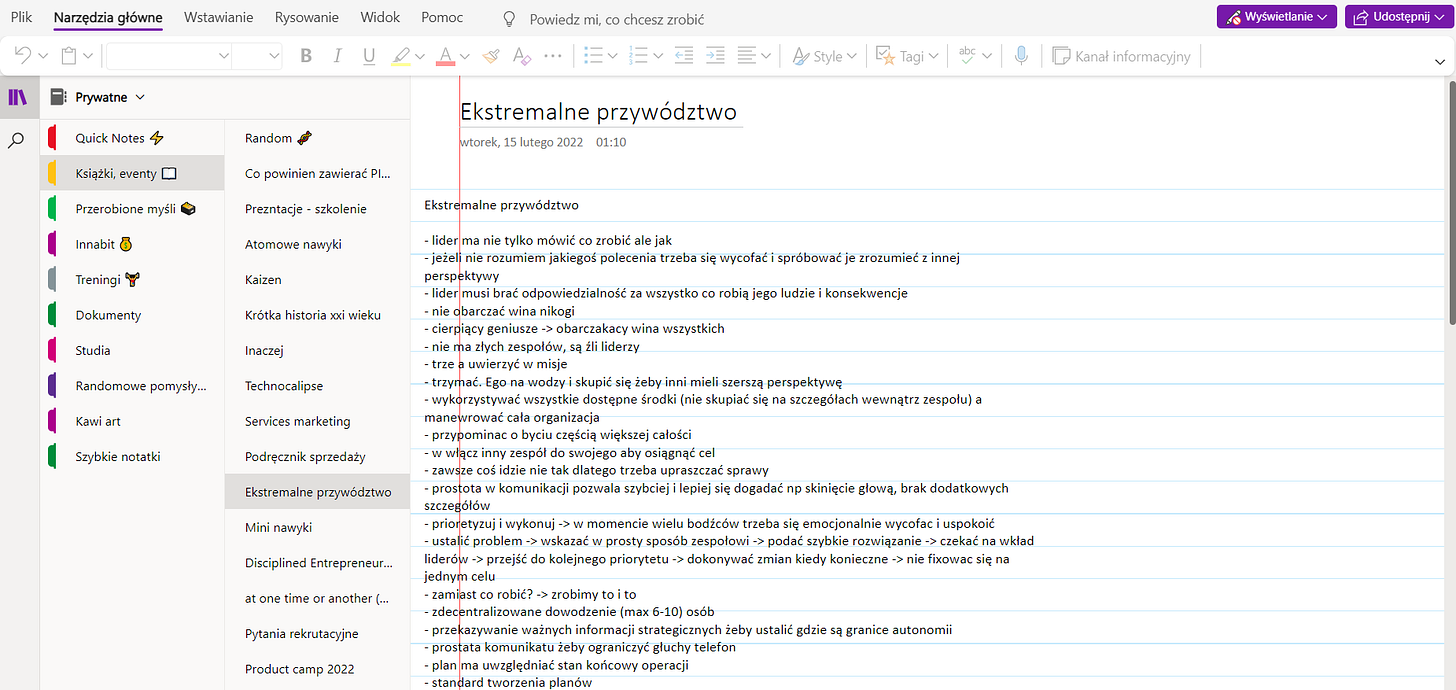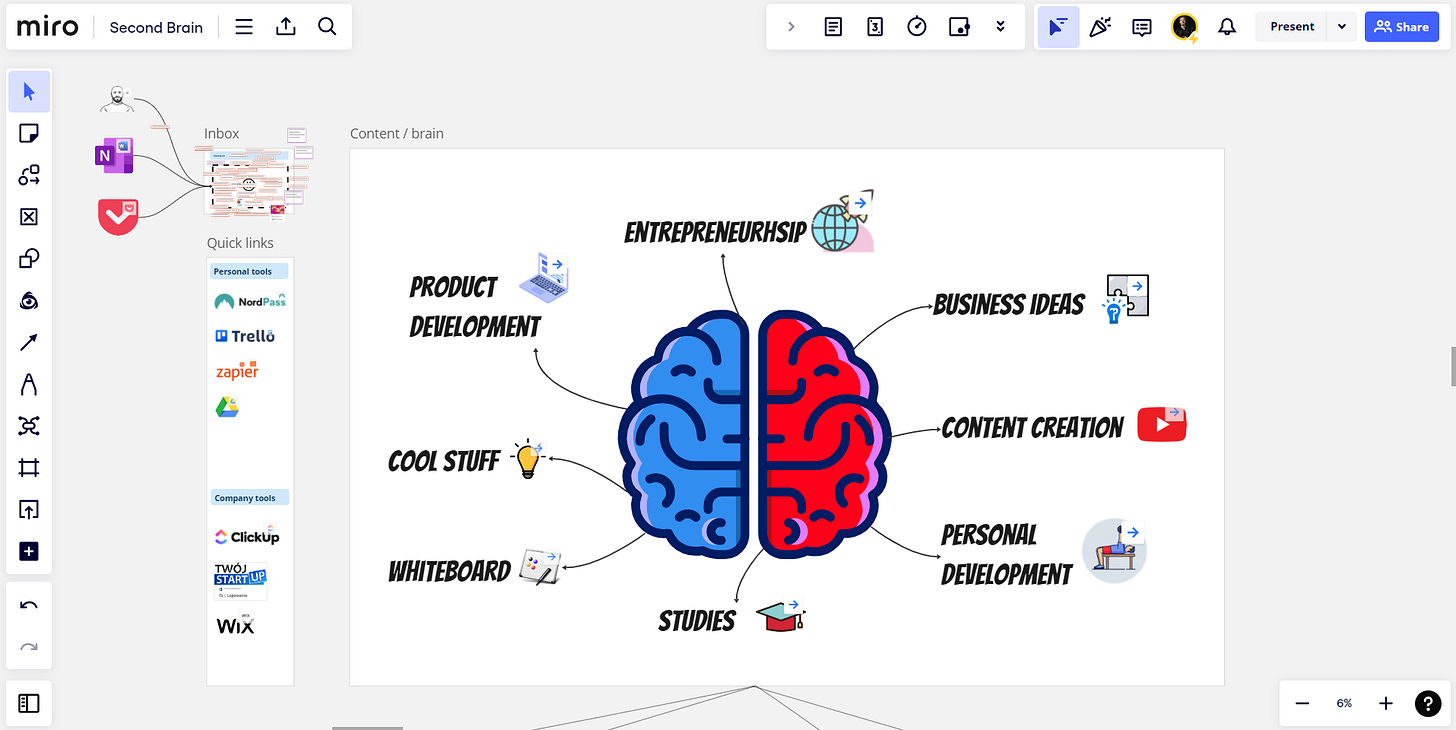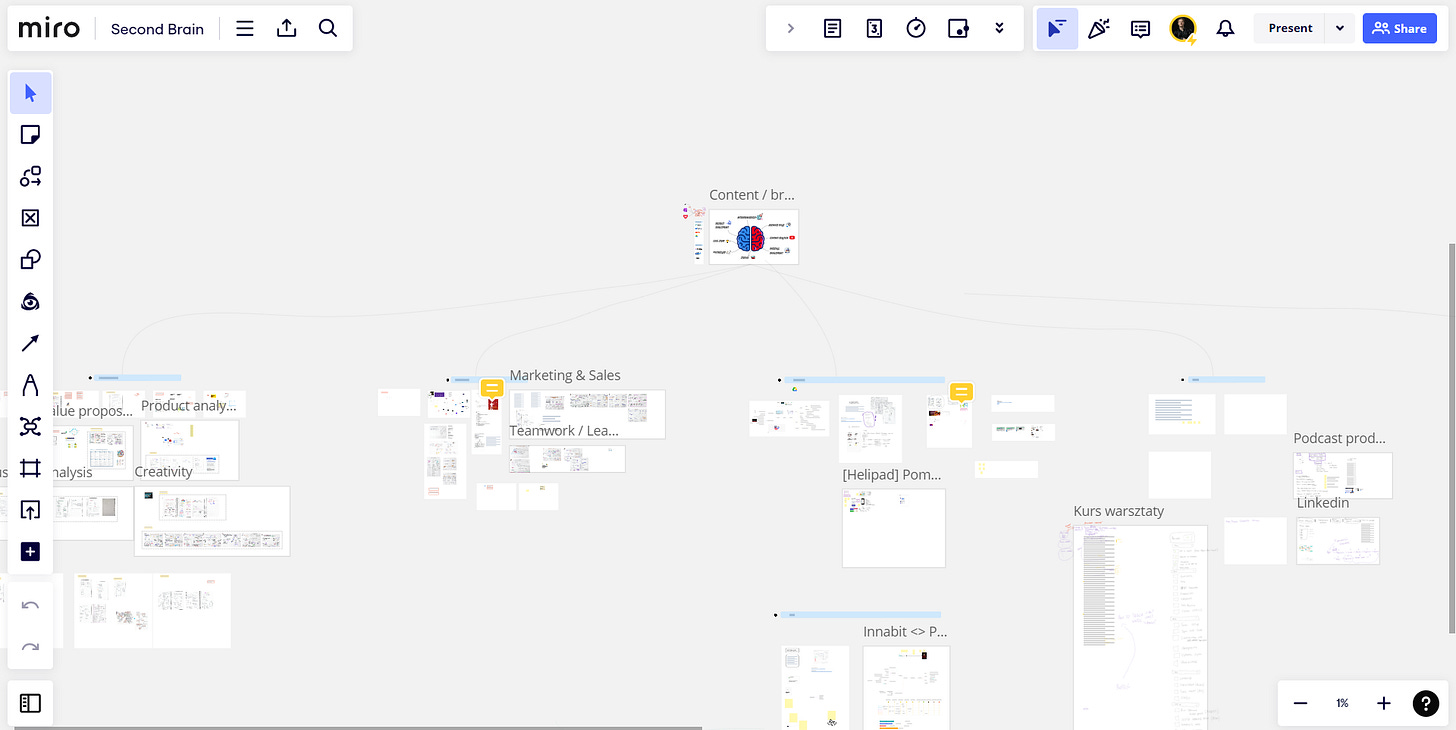Notion, Evernote, Obsidian are good for note-taking... But Miro is better
Why do I keep my notes in Miro (virtual whiteboard)?
Note-taking journey
If you've been interested in productivity, you probably considered different techniques for note-taking. Many people on the YouTube productivity scene (Ali Abdaal, Tiago Forte, Thomas Frank) swear by Notion or Obsidian. And indeed - they are undoubtedly great tools with endless possibilities for customization.
Yet, I could not convince myself to use them frequently. Something was off every time. But let’s get back to the beginning, so that you can understand my journey.
I've tried multiple apps on my way to find the best note-taking device, and here is a glimpse of the most important milestones:
1. The classic: paper
I started traditionally - with pen and paper. It's intimate and personal. But the organization was an issue. Reviewing pages of handwritten notes took a lot of work, and too often, I stumbled upon forgotten snippets that could have been of value earlier.
2. Evernote snippet
The digital world beckoned, and Evernote was my first stop. Its web-clipping feature seemed promising, and it'd bridge the gap between my online research and offline reflections. But instead, my notes remained scattered, disjointed from their original contexts.
3. The Obsidian experiment
With the buzz around Obsidian, I dived in, hoping for a cohesive note-taking system. While its concept of linking topics is innovative, I was limited by its lack of complete device compatibility and struggled to embed visual aids. Did not work out for me.
4. Notion / Clickup
Notion, the go-to for many. I decided I need to try it next. It cannot be so popular without a reason. I need to say, that this might be one of the most capable tools out there. It's versatile, housing databases, checklists, and more.
Yet, it’s not for me. While robust, its interface lacked the personal touch and visuals. I could not force myself to open it because the UI is simply… Not for me.
At the same time, I started testing Clickup for the purposes of my organization I worked with at the time. I decided to test it for my personal needs too. In my opinion, capability wise those two tools are nearly identical. The general idea behind them at least is. And because I already knew that Notion is not a good fit for my personal note-taking objectives, I didn’t find Clickup a good fit either.
In general comparison - Clickup added recently whiteboards as a basic feature (didn’t have it when I was testing it) and is easier to setup - it wins over Notion in my opinion. In theory it’s also free for unlimited members, but when you try to use things such as custom properties in databases, you quickly realize that you will want to pay for it to make your life easier.
I’m sorry, but I simply don’t like to use Notion. Clickup is better to use for organizations in my opinion, but still doesn’t hit the spot when it comes to private knowledge-management.
Nevertheless, both tools are great for companies and organizations. But if you ask me what tool should you use, for your small organization, I will probably say… “Hey, check my new article about a hidden choice”But for those of you whose teams started to grow, I will vote for Clickup. Simply because of much better UI and the fact of integrated whiteboards which covers more use cases.
5. Hidden in the spotlight: OneNote
Seeking a more vibrant platform, I stumbled upon OneNote. With it, I could draw, doodle, and write freely. But the app's inherent page-centric structure meant older notes got buried and forgotten.
Yet, another problem arises. Because The note structure assumes that there is one page for a given topic, I found myself in a situation where I needed to remember the information I kept there. I did not have any incentive to come back to it. At least OneNote gave me a good set of tools to draw with my pen, so I could be more creative.
…And this gave birth to a new idea: what if I could have an endless piece of paper for my hand-made notes? Could I put all the information on a single OneNote page?
WAIT. THAT'S WHAT ONLINE WHITEBOARD DO!
The online whiteboard epiphany
That's was a breakthrough moment for me. Online whiteboards came into the picture. After experimenting with Miro, Mural, Lucidcharts, and Draw.io, Miro emerged as the winner. With its expansive workspace, mobile compatibility, and varied content integration, it became my go-t
Big flaw and a workaround
Of course, no system is perfect. Miro's dependence on internet access was its Achilles heel. Yet, I found a simple workaround. Offline, I'd jot down ideas or sketches using my Samsung Notes app. These could be effortlessly migrated to Miro when online, which is very useful because it keeps all of my thoughts in one place.
As tech evolves, so will my methods. I always seek innovative platforms or features that enhance my productivity. Yet, for now, Miro's visual appeal, combined with its functional prowess, is unmatched.
The PARA method: a modern organizational blueprint
The digital note-taking realm is rife with systems, methodologies, and frameworks, all promising streamlined knowledge management. Among these, the PARA method, coined by Tiago Forte, stands out for its elegance and adaptability.
What is PARA?
PARA stands for Projects, Areas, Resources, and Archives. It's a simple yet powerful organizational framework that adapts to our ever-changing work and life scenarios. The strength of this framework lies in its flexibility. Instead of rigid hierarchies, it emphasizes the visibility of the most essential information, ready to use according to the current priorities. In general, it consists of:
Projects = tasks with a defined endpoint. Once done, they're out of your system.
Areas = ongoing spheres of activity that need constant attention, like health, career, or relationships.
Resources = collections of information you refer to but need to be immediately actionable, such as books, courses, or reference materials.
Archives = all the items that don't currently fit into the above categories might be helpful later.
PARA in Miro
Online whiteboards, particularly Miro, can be the perfect playground for PARA:
Create distinct boards for Projects, groups of frames for Areas, and frames for Resources. You could download the backup as Archives, move pieces to the remote spot, or create another board.
As tasks transition, expand, or change, drag and drop them to the appropriate section. Miro's intuitive interface facilitates this seamless movement.
Integration with other tools is also great. Whether you have resources in the form of PDFs, links, or even videos, Miro allows for easy embedding. This means your Resources section can be a rich tapestry of multimedia references.
There are many options to put your thoughts on the canvas - Mindmaps, drawings, icons, sticky notes, shapes etc.
Takeaway
Finding the perfect note-taking method is a journey, not a destination. It's about adapting, experimenting, and discovering what resonates with one's personal and professional needs. For me, the expansive canvas of Miro is where my ideas find a home. Yet, the essence isn't in the tool but in how one uses it. Implementing any system is only half the battle; consistency is key. With Miro, I developed a routine of weekly reviews, ensuring I kept track of ideas and could refine older ones. This habit made my note-taking more active and engaged.
One of the biggest switch for me, was to use the tool not for note-taking but knowledge management.
With that you can use frameworks as PARA, beauty lies in its simplicity and versatility, making it an ideal match setting up whatever tool.
Nevertheless, whether you're a seasoned note-taker or just starting, integrating PARA with Miro could revolutionize how you organize and engage with your information.





